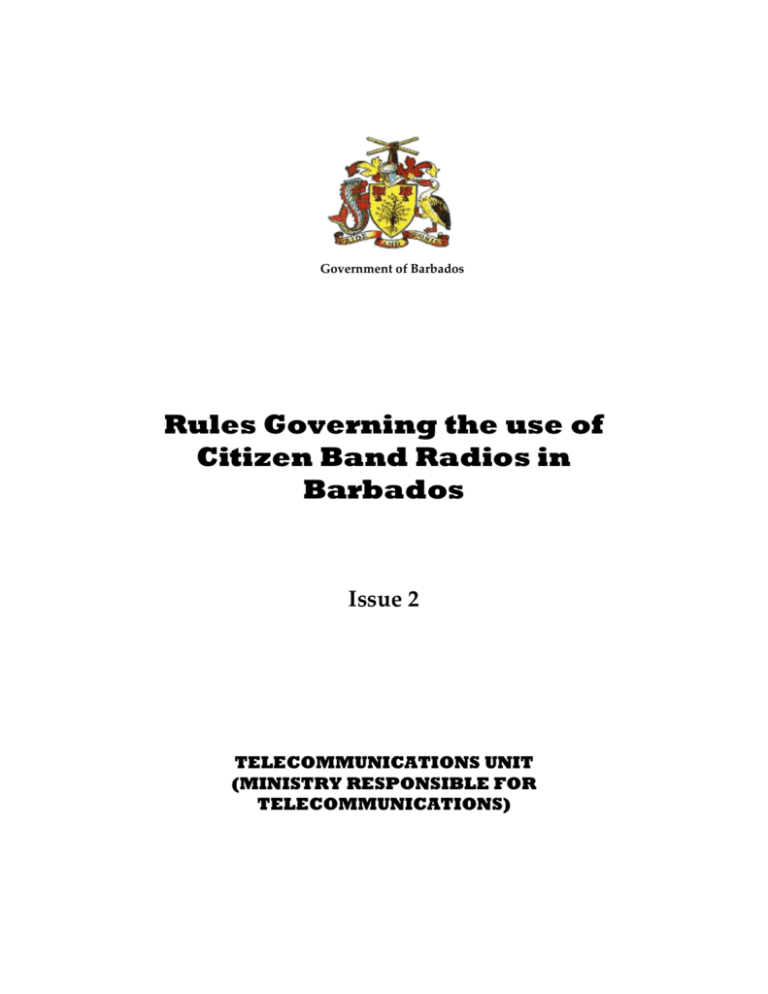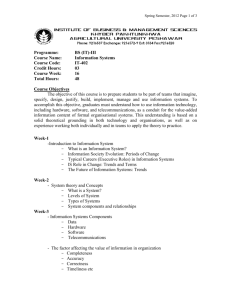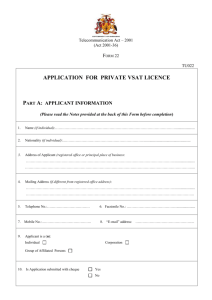Rules Governing the use of Citizen Band (CB)
advertisement

Government of Barbados Rules Governing the use of Citizen Band Radios in Barbados Issue 2 TELECOMMUNICATIONS UNIT (MINISTRY RESPONSIBLE FOR TELECOMMUNICATIONS) Rules Governing the use of Citizen Band Radios In Barbados TELECOMMUNICATIONS UNIT (MINISTRY RESPONSIBLE FOR TELECOMMUNICATIONS) 3rd Floor East, Warrens Office Complex, Warrens, St. Michael 2 Rules Governing the use of Citizen Band Radios in Barbados 1. FREQUENCIES (a) A Citizen Band Operator may transmit only on the following channels:- CHANNEL 1 2 3 4 5 6 7 8 9 10 11 12 13 14 15 16 17 18 19 20 FREQUENCY MHZ 26.965 26.975 26.985 27.005 27.015 27.025 27.035 27.055 27.065 27.075 27.085 27.105 27.115 27.125 27.135 27.155 27.165 27.175 27.185 27.205 CHANNEL 21 22 23 24 25 26 27 28 29 30 31 32 33 34 35 36 37 38 39 40 FREQUENCY MHZ 27.215 27.225 27.255 27.235 27.245 27.265 27.275 27.285 27.295 27.305 27.315 27.325 27.335 27.345 27.355 27.365 27.375 27.385 27.395 27.405 (b) Channel 9 may be used for emergency communications. (c) You must, at all times and on all channels, give priority to emergency communication messages concerning the immediate safety of life or the immediate protection of property. (d) Channel 7 may be used only for organized activities of public interest, to be determined by the Chief Telecommunications Officer on request. (e) All other channels must be shared with other users. 3 2. 3. 4. HEIGHT OF ANTENNA (a) The highest point must be more than six metres higher than the building or support on which is mounted. (b) The highest point must not be more than 18 metres above ground. (c) If the CB Station is located within ½ mile of the airport, you may contact the Chief Telecommunications Officer for maximum allowable height for the antenna. TYPE OF EQUIPMENT TO BE USED (a) Only equipment type approved by the Telecommunications Unit, in the Ministry responsible for Telecommunications may be used. (b) Any internal modifications to a type accepted CB transmitter cancels the type acceptance. (c) Only radios with 10kHz channel spacing between 26.695 MHz and 27.405 KHz may be considered CB equipment. SERVICING A CB TRANSMITTER (a) You may adjust your own antenna to your CB transmitter to make radio checks. (b) Each internal repair and each internal adjustment to your CB transmitter must be made by a qualified technician. (c) Each internal repair and internal adjustment of a CB transmitter in which signals are transmitted must be made using a non-radiating (dummy) antenna. (d) Brief test signals (signals not longer than one minute during any five minute period) using a radiating antenna may be transmitted in order to: (i) Adjust an antenna to a transmitter (ii) Detect or measure radiation of energy other than the intended signal (iii) Tune a receiver to your CB transmitter. 4 5. POWER (a) A CB transmitter power output must not exceed the following value under any condition: 6. 4 Watts output power (b) No linear or external radio frequency (RF) power amplifier may be used or attached to any CB station in any way. (c) There are no exceptions to this rule. (d) The Ministry responsible for Telecommunications will presume you have used a linear or other external RF amplifier if – (a) It is in your possession or on your premises. (b) There is evidence that you have operated your CB station with more power than allowed in this rule. PROHIBITED COMMUNICATIONS (a) A CB Station must not be used – 1. In connection with any activity which is against state laws. 2. To transmit obscene, indecent or profane words or meaning. 3. To interfere internally with the communications of another CB station. 4. To advertise or solicit the sale of any goods or services. 5. To transmit music, whistling sound effects, or any material to amuse or entertain. 6. To transmit any sound effect solely to attract attention. 7. To transmit the word “MAY DAY” or any other international distress signal, except when your station 5 is located on a ship, aircraft or other vehicle which is threatened by grave and imminent danger and you are requesting immediate help. 7. 8. To advertise a political candidate or political campaign. 9. To transmit communications for live or delayed rebroadcast on a radio or television broadcast station. 10. To communicate with unlicensed stations. 11. To transmit a false or deceptive communication. 12. You must obey any restrictions that the telephone company or Ministry responsible for Telecommunications places on the connection of a CB transmitter to a telephone. THE RESPONSIBILITIES FOR TRANSMISSION MADE UNDER THE AUTHORITY OF LICENCE (a) The licensee is responsible for all transmissions made by him or others under the authority of his licence including transmissions which are against these rules. A licensee should be certain that anyone operating under his licence understands and obeys the rules. (b) (c) 8. A licensee should not permit any person to operate under his licence who no longer holds a licence to operate because: (1) his licence was revoked by the Ministry responsible for Telecommunications, or (2) His licence was surrendered for cancellation after the Ministry responsible for Telecommunications instituted revocation proceedings. If you sell a CB transmitter or transmitters, you must not allow a customer to operate a CB transmitter under the authority of your licence. LENGTH OF COMMUNICATIONS (a) Your communications must be limited to the minimum practical time. 6 9. 10. 11. (b) If you are communicating with another CB station or stations, you and the other stations must limit each of your conservations to no more than five (5) continuous minutes. (c) At the end of your conversation, you, and the stations communicating with you, must not transmit again for at least one minute. IDENTIFICATION OF CB STATION (a) You must identify your CB station by the Ministry responsible for Telecommunications assigned CALL SIGN and number at the Beginning and Ending of each communication. (c) Your Ministry responsible for Telecommunications CALL SIGN AND NUMBER must be clearly given in English Language. A phonetic may be used as an aid for identification. STATION INSPECTION (a) Your CB station must be made available for inspection by the Chief Telecommunications Officer or his nominee. (b) A CB station includes all the radio equipment for use. STATION RECORD Your station record should include the following documents: 12. 1. Your CB licence. 2. A list of authorized users of your CB station. 3. A current copy of these CB rules. THE USE OF CB STATION 1. You must at all times give priority to emergency communications. 7 13. 14. 2. You may use your CB station for communications necessary to assist a traveler to reach a destination or receive necessary service. 3. You may transmit your personal business activities or those of members of your immediate family living in your household. 4. Emergencies. 5. Traveler assistance. 6. Department of Emergency Management (DEM) activities in connection with official tests or drills conducted by DEM LICENCE FEE 1. The licence fee is $45.00 for a Mobile or Hand portable Station per annum. 2. Base Station fee is $60.00 per annum. 3. All licences expire on 31st December, and should be renewed NOT LATER than 30th January of each year. 4. A licence may be obtained any working day during the year. CB STATION STATUTORY RULES 1. If the Ministry responsible for Telecommunications finds that a person who operates a CB, willfully or repeatedly violates rules which prohibit the use of obscene, indecent or profane language, then that person is liable, on summary conviction, to a fine of $10 000, or to imprisonment for a term of 12 months. 2. A person who (a) uses his CB Station for the purpose of interfering with any telecommunication; or (b) neglects to take appropriate measures to reduce interference to the satisfaction of an inspector commits an offence and is liable on summary conviction to a fine of $50 000 or to imprisonment for one year or to both. 8 3. A person who owns or operates a CB Station without a licence commits an offence and is liable on conviction on indictment to a fine of $250 000 or to imprisonment for a term of 3 years. 4. Where a magistrate is satisfied by information on oath that there is reasonable ground for suspecting that an offence under the Telecommunications Act, Cap 282B, has been committed or is about to be committed, the magistrate may issue a search warrant authorising the inspector named in the warrant, with or without a member of the Police Force to 5. (a) enter and search the vehicle, ship, vessel, aircraft or premises specified in the information; and (b) examine, test or seize any document, extract of a document, telecommunications or radiocommunications apparatus or other item. A person who (a) wilfully obstructs, hinders, molests or assaults or otherwise interferes with an inspector engaged in the performance of any duty or the exercise of any power conferred on him under this Act; or (b) knowingly gives false information to an inspector, commits an offence and is liable on summary conviction to a fine of $50 000 or to imprisonment for a term of 6 months. 6. If the licensee has contravened any provisions of the Telecommunications Act, Cap 282B, the regulations or conditions of his licence, the Minister responsible for Telecommunications may suspend, revoke, modify or refuse to renew his licence. Citizens Band radio operators have largely adopted the “10-code” for standard questions and answers. Its use permits faster communications and better understanding in noisy areas. The following table lists some of the more common codes and their meanings. 9 Code Meaning 10-1 Receiving poorly 10-2 Receiving well 10-3 Stop transmitting 10-4 OK, message received 10-5 Relay message 10-6 Busy, stand by 10-7 Out of service, leaving air 10-8 In service, subject to call 10-9 Repeat message 10-10 Transmission completed, standing by 10-11 Talking too rapidly 10-12 Visitors present 10-13 Advise Weather/Road Conditions 10-16 Make pick up at 10-17 Urgent Business 10-18 Anything for us? 10-19 Nothing for you, return to base 10-20 My location is 10-21 Call by telephone 10-22 Report in person to 10-23 Stand by 10-24 Completed last assignment 10-25 Can you contact 10-26 Disregard last information 10-27 I am moving to channel 10-28 Identify your station 10-29 Time is up for contact 10-30 Does not conform to FCC rules 10-32 I will give you a radio check 10-33 EMERGENCY TRAFFIC 10-34 Trouble at this station Code Meaning 10-35 Confidential information 10-36 Correct time is 10-37 Wrecker needed at 10-38 Ambulance needed at 10-39 Your message delivered 10-41 Please turn to channel 10-42 Traffic accident at 10-43 Traffic Tie up to 10-44 I have a message for you 10-45 All units within range please report 10-50 Break channel 10-60 What is next message Number? 10-62 Unable to copy, use phone 10-63 Net directed to 10-64 Net clear 10-65 Awaiting your next message/assignment 10-67 All units comply 10-70 Fire at 10-71 Proceed with transmission in Sequence? 10-77 Negative contact? 10-81 Reserve hotel room for? 10-82 Reserve room for 10-84 My telephone number is 10-85 My address is 10-91 Talk closer to mike 10-93 Check my frequency on this channel 10-94 Please give me a long count 10-99 Mission completed, all units secure 10-200 Police needed at 10



